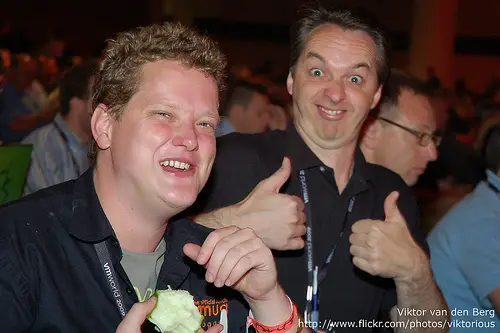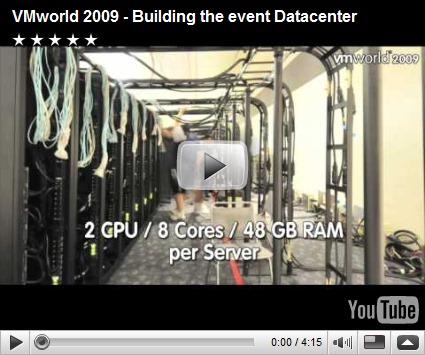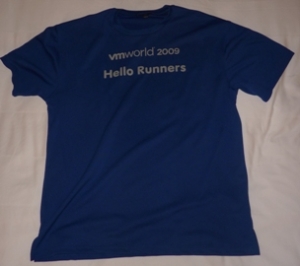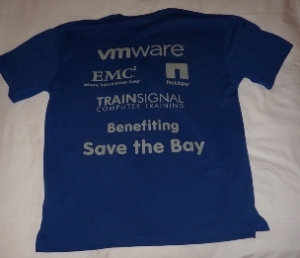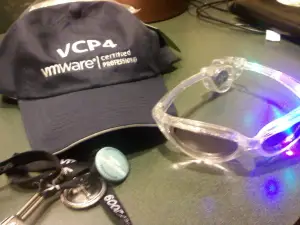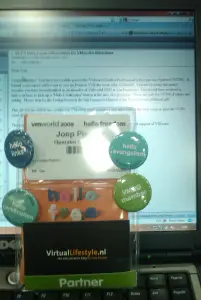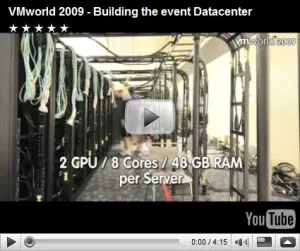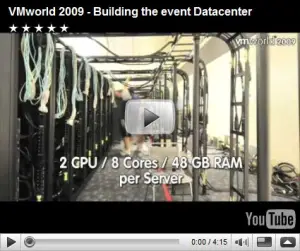More blogs on VMworld 2009!
I take no credit for any of this content, it go’s to the a, and mean to only put the content here without having to weed through the varies blogs, I have both the blog link, and article title here, with a link to the article. Thanks to everyone for putting these together for everyone to read!
http://dantedog29.blogspot.com : Notes on the VMworld Opening Day Keynote
“
I didn’t want to do this, I had high hopes for this Keynote, wanted to hear something cool, but I wasn’t impressed. After sleeping through the Opening Day Keynote, So what is the future of VMware?
It was a very low and understated keynote. No excitement whatsoever. I will bold out what I think were cool announcements, and you can read my commentary on the rest.
Todd comes out and talk about how VMware is now this Platform of IT. He says that VMware has 96% of the Global 1000 and that at their Partner Conference they said get the rest. They got 10 more of these and so they have 97% of the Global 1000.
FInancial Energy, Human Energy, Earth’s Energy
Kroger, Siemens, Fannie Mae *Customer video
42% Infrastructure Maintenance, 30% app maint, 23% app invest, 5% infra invest
10 minutes in, and nothing exciting or new talked about. Todd and Paul came in and beat their chests a little, but really there was NOTHING NEW. Disappointing. Take the Hardware, encapsulate the OS/App into a “little black box” lift it up and Slide VMware vSphere in there. Now you can push it out to the cloud.
Automatic Operations leads to Business Agility
This could be interesting. Reverse DPM? When Power is expensive (and usually demand for resources higher) squeeze the servers onto a box and save power.
32 minutes in, again, nothing new. Yawn. These are all slides I have seen before, and they weren’t presented very excitingly. I saw these at VMworld Europe, at the vSphere 4 Launch, nothing new.
VMware and IBM “dialing the power down” lessening the idle power.
Creating a new VM with Lab Manager, WOW?
vCenter Chargeback weight the resources
VMware Go? VMware Went…How do I make money off of those people that download and use ESXi for free.
vCloud Express – Fast and Cheap uhh, Fast and Cost Effective
vCloud API – Announcing (again?) this Open Cloud API
VMware View – Desktop as a Service
HP showed a couple of things that are interesting. First of all, they had this storage device and you could pull it out and all of the disks were built in to the side. That was cool.
Also, HP has built in their Insight Manager Tools built into vCenter which can monitor your servers and then if you need to go into their tools (you need more depth) then you can launch it. Paul commented on how this is a Single Pane of Glass for managing the physical and virtual. Granted you still have to pop out to get to the OA, but interesting.”
—–
http://blog.scottlowe.org : BC1500 – Site Recovery Manager Best Practices
“
I arrived at this session a few minutes late because the VMworld 2009 Day 1 keynote was running late. The early part of the session was pretty straightforward with information on the various SRM components: multiple vCenter Server instances, SRM servers, storage replication, SRAs, etc., so I won’t bother recreating this here. Most people are already familiar with the basics of SRM.
The technology preview of SRM (the beta of the next version) does support vCenter Server linked mode, which means that your two vCenter Server instances can run in a linked mode group. Very nice!
The next version of SRM will allow you to change the authentication option via a Repair installation. This is a big improvement from the current release, where this has to be selected at installation and can’t be changed afterward.
VMware KB article 1008390 provides more information on how to setup the self-signed certificates and which subject names should be used for correct operation.
It’s important to remember that SRM doesn’t perform replication; the storage performs the replication. The SRA allows SRM to control the movement of that storage and how it is presented to the various hosts involved in the solution.
The SRA is written by the storage vendor and must be installed on both SRM servers. Multiple SRAs can be installed on the same SRM server to support multiple storage platforms. New adapters do not require SRM updates. The SRA then supports tasks such as setup, testing, and failover. So what goes wrong with SRAs?
- Not all SRAs are created equal. They support the same functionality but the implementation might be different.
- Some SRAs have external requirements, such as the Java JRE, or storage-specific components from the storage vendor. The key takeaway is to be sure to read the documentation from the storage vendor about the SRA. The SRM community forum can also be a good source of information.
- SRAs expect a certain level of replicated storage configuration. This might include little quirks like ensuring that certain flags or attributes are set as expected by the SRA.
Some SRAs talk directly to the storage array, but some SRAs require connectivity to a control station or management station. Again, be sure to refer to the SRA documentation to be sure of the configuration requirements.
Recommendation: whatever you do at one site, duplicate that effort at the other site. This will help simplify things.
Some storage arrays require access to “gatekeeper LUNs”; when running SRM as a VM, you can present these LUNs to the SRM VMs as RDMs. Other storage implementations, like HP EVA or IBM SVC, need access to the management server itself and not to the array directly. HP recently released a guide to using SRM with HP storage that might be a good idea to read.
Other pitfalls during SRA setup:
- Attempts to configure SRA at protected site will fail if SRA components are not installed at recovery site.
- For active/passive setup, just perform configuration at the protected site, not the recovery site. Configuration at the recovery site is only required for failback or active/active setups.
- Double-check path definitions; older SRAs used Perl or similar and caused problems with failing to update the path definitions. Get updated SRAs; this has all been fixed in newer versions of the SRAs.
- Be sure the array configuration matches the pre-requisites.
- SRM might need additional licensed features in order to perform a Test failover. (Key example: FlexClone required on a NetApp array in order to perform test failovers.)
- Empty datastores won’t be detected by SRM even if it is replicated. This has been fixed in the next release.
Next the presenter shifts to a discussion of virtual machine networking.
SRM will work with stretched VLANs. To architect SRM to work with stretched VLANs and failover tests, you can use the bubble network, but that isn’t really practical. Instead, the presenter recommends the creation of test VLANs on the physical network to support failover testing.
Instead of stretched VLANs, you can also use disparate networks. In this case, of course, the VLANs change from the protected site to the recovery site. This impacts IP addressing, DNS, Active Directory, default gateways, DHCP, etc. You can use existing tools to fix these problems; you don’t have to use the SRM-supplied tools. SRM supplied tools include VM customization or the dr-ip-customizer.exe batch utility. Dynamic DNS updates are another option as well.
So what about virtual machine disks? What are the storage factors that come into play here?
- Current version of SRM supports iSCSI and Fibre Channel, and supports both physical and virtual RDMs
- VMs can span multiple datastores (but need to consider replication consistency)
- SRM does not support VM snapshots
- VMs cannot span arrays, even arrays of the same type
The presenter next moves into a section he called “Running,” but it was really more about how to walk through the site pairing, storage array configuration, and inventory mapping (more setup and configuration than operation, in my opinion).
A few notes about protection groups, placeholder VMs, and recovery plans:
- SRM supports up to 150 protection groups. Each protection group may have multiple LUNs.
- SRM supports up to 500 VMs. This should increase to 1000 VMs per site in the next release.
- Need a datastore at the recovery site to hold VM placeholders. This datastore does not need to be replicated. Each placeholder is typically <1KB each, so there is not a lot of storage required.
- Don’t delete the placeholders; this breaks the SRM configuration.
- SRM supports multiple recovery plans, so you can use mutliple plans to support multiple recovery targets.
- Recovery plans support permissions, so not everyone needs access to all plans.
In general, also be sure to keep in mind the “upstream” and “downstream” dependencies. SRM isn’t going to fix dependencies for Microsoft Exchange, for example.
I’m ending coverage here, because I have to leave to go to a special, super-secret press announcement with Paul Maritz. I’m not allowed to blog, tweet, or any such thing during the press announcement, so you’ll have to wait until after the event to hear anything from me.”
———-
http://netapptips.com/ : VMworld 2009: Preview of the Day (Tuesday)
“
Posted by Brian Gracely – Sr.Manager, Virtualization Architecture and Marketing
All you need to do is follow the Twitterstream from yesterday and last night to realize that VMworld 2009 is off to a huge start and that today is going to be even bigger. Quick recap of yesterday and then a preview of all things NetApp that you’ll be able to find in and around the show.
Day 1 (Monday)
- Summary of NetApp and NetApp-related announcements
- NetApp sponsored the Golden Gate Bridge run yesterday evening
- NetApp’s first technical book at VMworld (NetApp and vSphere Storage Best Practices) went on sale in the VMworld bookstore. This is for those of you that might want it in a book format.
- Kicked off the opening of the booth (#2102) area with the unveiling of 12 new demos, highlighting Storage Efficiency, Data Protection, Cloud Computing / Management Automation, and Virtual Desktops
Yesterday’s product announcements for RCU 2.1, SMVI 2.0 and VSC highlighted NetApp’s continuing commitment to partnering extremely close with VMware to integrate all of our products into the vCenter management platofrm. It also highlights our vision to bring greater operational automation to customers moving to virtualized data centers.
Day 2 (Tuesday)
- Come visit the NetApp booth (#2102) and check out the mini-theatre presentations every 20 minutes. DataMotion, Large Scale VDI Deployments, SMVI 2.0, RCU 2.1, VSC, Secure Multi-Tenant Cloud Architecture will all be covered by our expert speakers.
- @Vaughn_Stewart and Cisco Dist.CSE Jim French will be speaking in the Cisco mini-theatre at 11am on combining the power of NetApp VDI and Cisco WAAS to deliver cost-effective Virtual Desktop solution.
- NetApp customer Thomson-Reuters will be presenting on "Large Scale Virtualization" in Session VM3142 at 11:30am in North Hall, Room 110
- NetApp’s Jeff O’Neal (Sr.Director of Cloud Solutions) will be speaking in the Cloud Pavilion (booth 1614) at 1:50pm
- NetApp’s Phil Brotherton (VP/GM Virtualization BU) and Cisco’s Ed Bugnion (CTO/VP, SAVBU) will be presenting "Deploying the Foundation for a Virtualized Dynamic Data Center" in Session TA4860 at 3pm in Esplanade Room 304.
As you can see, NetApp will be all of the show, with many opportunities for you to come hear about our vision, latest technologies, or just ask questions about your networks and designs. All of the Virtualization TMEs (@Vaughn_Stewart, @Jack_McLeod, @Abhinav_Joshi, @slisinger, Peter Learmonth, and Larry Touchette) will be around the NetApp booth all and look forward to meeting with you and answering your questions.
Follow me on Twitter, @bgracely”
—–
http://www.virtuallifestyle.nl : VMworld ‘09 Tuesday Keynote
“
Straight from the keynote, I’m videotaping and taking notes. I’ll update this post over the upcoming hours with new information. First, I’ll let you enjoy a small video impression of the keynote:
An interesting fact whooshed by without any mention on stage, but Gabrie noticed it: the IBM power management demo on stage was using VMware ESX 4.1. As the download section of VMware.com is down (as is the patch section), I have a hunch that ESX 4.1 will launch anytime soon.
A small demo about VMware vCloud Express was given, which, under the vCloud Initiative, will enable customers to create and manage virtual machines in the (internal or external) cloud with one of the VMware vCloud Partners. Check it out over at http://vcloudexpress.terremark.com/
Be sure to check out Viktor’s photos of the event on Flickr:
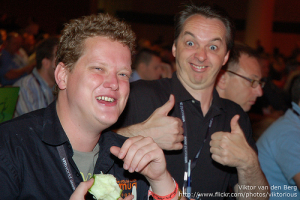
There’s no way known to mankind to thank John Troyer enough for his tremendous effort in organizing the VMworld ‘09 Tweetup. After meeting at the VMware Communities Lounge at the Solutions Exchange, we headed over to B Restaurant on top of the Moscone centre.
It was loads of fun meeting all of my co-bloggers, enjoying a free beer and seeing John make announcements:
(note click links for video )
—–
http://virtualfuture.info : VMworld 2009: Hands-on Lab sessions
“
Yesterday I did 2 hands-on lab session at VMworld that were very good and I would suggest to try to get into these labs. When you haven’t registered there is still a good chance to get in, at least from what I have seen today. There were a lot of people waiting to get in, but I think most of the people that did not register for the lab still could get in.
LAB 4: VMware vSphere™ 4 – Performance Optimization & Troubleshooting
You can expect to use vCenter, esxtop, and vscsiStats to identify and troubleshoot performance issues related to: Improperly configured storage, aggressively over-committed memory, heavy use of SMP virtual machines and other memory, CPU, storage, network, guest OS, and application issues. Scott Drummonds was the presenter of this lab and I must say that he and the other lab-staff members did a real good job. If you can’t get into this lab, you should really read more about vscsiStats.
LAB 5: VMware vSphere™ 4 – Security Hardening & Best Practices (vShield Zones)
In this lab I got the chance to play with the vShield Zones Firewall Virtual Appliance along with the VMware vNetwork Distributed Switch, 802.1Q VLANs, and some of the new role based access controls. It was a good lab to get some hands-on experience with vShield-Zones.”
—
http://blog.scottlowe.org : VMworld 2009 Day 1 Keynote
“
Tuesday, September 1, 2009 in Virtualization by slowe
(Note: You can also follow my Twitter updates here.)
I start out the Day 1 keynote at VMworld 2009 at the bloggers’ table, sitting with folks like Rodney Haywood, Mike Laverick, Alessandro Perilli, Rich Brambley, Thomas Bryant, Bob Plankers, and—of course—the ever-present John Troyer. There should be some good coverage of the event. Later today, I’ll update this post with links to the coverage from some of the other bloggers here.
The keynote session starts off with Todd Nielsen, VMware’s Chief Operating Officer (COO). He recounts the story of how he challenged the partners at Partner Exchange to win over one of the 40 customers in the Fortune 1000 for a free pass to the conference. It turns out that 10 of those 40 customers did switch to VMware, so there are now only 30 companies left in the Fortune 1000 that don’t use VMware software.
Mr. Nielsen then goes on to recognize the conference sponsors and the lab sponsors.
The VMworld 2009 conference has 12,488 attendees. That’s up quite a bit from the estimated attendance of only 8,000 attendees. It’s also funny how marketing and sales like’s to up those sorts of numbers (”It’s almost 15,000!”)
Mr. Nielsen goes on to talk about how VMware is driving cost savings (optimize financial energy), shift human energy, and save the Earth’s energy (via power reduction). Together these help VMWare “energize business through IT.” Spend more money on innovation, and less money on maintenance. This has been a key statement in VMware’s marketing over the last few months.
Now Paul Maritz takes the stage. He starts out by echoing Mr. Nielsen’s comments about needing to spend more on innovation instead of spending on maintenance. Mr. Maritz believes that business agility depends upon IT agility, and IT agility depends upon virtualization.
Mr. Maritz now moves the discussion to—what else?—the idea of cloud computing. He believes that virtualization is a key enabler, a key component, of cloud computing. It allows organizations to insert “cloud mojo” into their data centers. VMware vSphere is the product that provides the ability for organizations to transform their data centers and create private clouds. Once an organization has built their private cloud, VMware vCloud creates the bridge to external clouds.
The virtualization journey starts with CapEx savings and server consolidation, continues on to OpEx savings and internal/external cloud, and finishes with IT agility and business agility. According to Mr. Maritz, the release of VMware vSphere is a bigger release than any Windows release on which he worked while at Microsoft. (Is that a good thing?)
Next, Mr. Maritz reviews the vSphere architecture and discusses the new features and functionality that have been added to the product in this release. This includes DPM, new storage optimizations (more than 350,000 IOPS from a single server), new networking, etc. He reiterates: “There is now literally no application that cannot be considered a candidate for virtualization.”
So what is VMware doing with this great virtualization layer? VMware is introducing a family of new products that address specific usage scenarios. Mr. Maritz is referring to the vCenter family of products; not only vCenter Server, but Chargeback, AppSpeed, etc. His initial focus on vCenter is around the ability of integrate vCenter with other products via APIs. To that point, Mr. Maritz brings out an IBM representative to discuss how IBM is leveraging vCenter APIs to provide integration. This is illustrated with a demonstration of how IBM’s power meter, embedded in the IBM hardware, has been integrated with vCenter Server.
In the demonstration, IBM shows how their power meter is reporting power usage back to vCenter Server. This information is being reported not only for the physical hosts, but power is being reported for virtual machines as well. (I wonder upon which metrics IBM is basing virtual machine power usage?)
Following the demonstration, Mr. Maritz moves on to some new members of the vCenter family: capacity planning (CapacityIQ), configuration (ConfigControl), operations (Chargeback?), and continuity (SRM). Additionally, VMware is introducing products or technologies to create service profiles, service catalogs, enable self-service, and further extend chargeback functionality. In addition, VMware will be focusing on increasing app visibility.
This leads into another demonstration, this time with Bruce of VMware. Bruce is going to be demonstrating Lab Manager 4.0, which is enabling the self-service aspect of the private cloud. Next up Bruce and Mr. Maritz walk through a demonstration of vCenter Chargeback.
The discussion moves on now to vSphere Essentials, which provides “IT in a box” for smaller organizations. VMware is extending their push into the SMB market with VMware Go, a new service being introduced by VMware this week at the conference. VMware Go is a set of web-based services targeted at the SMB customers that helps automate the installation of VMware ESXi and helps engage partners and the virtualization community.
The next stage of the virtualization journey is bridging the connection to the external cloud. This leads into a discussion of VMware vCloud and vCloud Express. To help make this possible, VMware is adding a new construct called the “virtual datacenter”. The virtual datacenter allows organizations to amalgamate internal and external clouds for management, provisioning, resource allocation, etc. A key to making this work is having external providers ready to work with organizations and VMware to enable them to slide virtual datacenters from the internal cloud to the external cloud. (This sounds great and wonderful, but I think there are a lot of challenges yet to be addressed before this becomes reality.)
Mr. Maritz at least recognizes that organizations must have the ability to migrate out of the cloud as well as into the cloud. That’s better than some people I hear talking about cloud computing.
vCloud Express is targeted at providing the ability to quickly and cost-effectively turn up virtualized resources, targeting the sort of things that organizations can do today with Amazon. Bruce comes back out again for a demo of vCloud Express, created in conjunction with VMware’s partner Terremark. (vCloud Express looks interesting, although I’m not sure how excited companies will be about the ability for their employees to go create new virtual machines with an external provider for “only $20-30 per month”.)
Today VMware is formally announcing the vCloud API. This is something that VMware has been discussing for quite some time. In addition, this API is being submitted to standards organizations (the DMTF, I believe).
Another part of VMware’s “virtualization journey” involves desktop virtualization with VMware View. To help further discuss VMware View and how desktop virtualization is evolving, Mr. Maritz invites out Todd Dupree from HP. (While I love HP, this part is mostly a commercial. Bummer.)
Todd from HP does, at least, take a few minutes to discuss a new product from HP, Insight Control for VMware View. This is reasonably interesting and relatively well-integrated into vCenter Server and the vSphere Client, and provides hooks back into other HP products and management consoles.
PCoIP (PC over IP) is key component of ubiquitous desktop virtualization. To help illustrate that, Mr. Maritz next invites Chris Renter, of TELUS Communications in Canada. Mr. Renter logs into a virtual desktop using the next version of VMware View—presumably using PCoIP—to provide a short commercial about TELUS and how TELUS is using VMware View.
Mr. Maritz now moves into a discussion of the SpringSource acquisition, as a “final step” in the virtualization journey. Why is the SpringSource acquisition important? VMware believes that the use of lightweight frameworks and virtualization will result in “radical simplification” and will help eliminate redundant and complex layers of management. Mr. Maritz reiterates the commitment to keep the Spring framework as an open source project, and that the Spring framework will continue to support multiple platforms and Java services. What will VMware do with SpringSource? The idea is to find ways to slide the Spring framework onto VMware vSphere and enable ways for Spring to inform the hypervisor about application requirements and behaviors. To help show this off, Mr. Maritz invites Rod Johnson to take the stage and show off some of the SpringSource functionality.
My next session starts in 5 minutes, so I’m packing it up now and moving on. I’ll update this post later with links to other bloggers’ coverage of the keynote.”
—-
http://vmetc.com : VMworld 2009 Tuesday Keynote
“
I will be live blogging the VMworld 2009 Tuesday Keynote from the Moscone Center in San Francisco, CA this morning. This post will be frequently updated with my notes and impressions once the Keynote begins.
Keynote 1 Live Blog
7:36 am PST – in my seat. Already tweeting. Not sure if I’ll primarily post live notes or just use tweets. Hit F5 to refresh every couple of minutes.
8:02 am – keynote still not started yet. I’m sure we are close …
8:05 am – announcement made to turn cell phones off. I’ve been tweeting Twicpics in my Tweetgrid on second page of post
8:11 am – we’ve started!!
Discussing the issues reported with the hands on labs yesterday. I had heard through the grapevine that one HP rack was dropped, and this damaged impacted close to 50% of the labs compute power. We’ve been told this is almost completely restored.
Just lost wifi. Successfully made switch to Sprint card for now.
Video showing customer testimonials now
8:20 am – Paul Maritz takes the stage
The current slide says Evolution or Revolution? Paul is talking about a hunger to get to the cloud, but he makes the point that it’s a mythical world today that most don’t know how to define how to get there. He is explaining that virtualization is the answer.
New slides this year explain that vSphere is sliding the cloud functionality into the datacenter. I like this approach. In the past the idea of moving the datacenter to the cloud seemed to confuse most.
Now Paul is discussing the virtualization journey. Server Consolidation leads to an internal/external cloud and automatic operations. In turn this means capex and opex savings and ultimately business agility. Images of VI 3 are on the monitors, and then segue to vSphere and a cloud operating system. Paul is runninng through the VMware vSphere platform slide showing the application and infrastructure services we have sen repeatedly over the last 12 months.
The discussion is now shifting to automatic, dynamically reacting datacenters. Both at the application and the infrastructure levels, VMware is ready to provide this type of scalable and robust service with the help of partners like Intel, Cisco and EMC. Paul is thanking the VMware partners that have added functionality to vSphere. He mentions that vSphere is ready to virtualize all applications, and shows an adoption graph to show the number of companies using VMware datacenter products is continuing to rise.
On to discussing VMware vCenter and the management of vSphere environments
Tom Brey from IBM is invited on stage. He is providing a demo of using IBM’s System Director to provide vSphere utilization per watt? 8 VMs are running on a x3650. Tom is explaining that the idea usage of these VMs is consuming a small amount of energy by displaying this info on the Peformance tab of vCenter. IBM has put a lot of energy saving technology on their servers and he is explaining how that helps. He is now starting another 8? VMs to increase the workload on the vSphere host. The Performance tab is shown again and supposedly shows that idle power does not increase that much. I have to admit, they lost me. The graph seemed to double to me as would be expected. The point is well taken however – IBM servers should help with power consumption when running vSphere servers.
Paul takes back over the stage and starts introducing the new vCenter suite of products. This leads to a LabMnager demo.
Bruce ? is on stage with Paul and he is showing the LabManger library and demonstrating cloning a workspace. He mentions the use of linked clones and how quick the cloning the process is. 10 seconds later a new workspace of VMs is ready to go.
Next in the demo is Chargeback. A web interface is being shown on the monitor that is showing the ability to assign costs to ESX resources. An online report is genrated for the month of August and is pushed out to a spread sheet and then a graph. Pretty slick.
Paul now shifts to discussing vSphere Enterprise Essentials for SMB. The slide shows “IT in a Box” for the small business.
He’s started to explain the new VMware Go – web based automation for the configuration and installation of ESXi. He explains VMware wants to also build a community around this product as well?
Next the topic is a what Paul calls a new concept of virtualization based cloud datacenters. His vision is that the private internal cloud datacenter can be easily moved in entirety to a hosted external cloud provider. Of course, this vision includes a single management interface. I think this is hinting at the vCloud API just announced yesterday. I’ll post more about that later this week. Paul hints that some of the most respected names in the industry will join him in a cloud announcement later this morning. He mentions vCloud Express will be a fast and cost effective way to deploy datacenters.
Bruce is back for a vCloud Express demo
He is showing a web interface with the vCloud Interface. He registers with a credit cardm gets an email that everything is ready, logs in, chooses to build an Ubuntu server form a list of vSphere supported OSes. he then points out that this server will cost about 5 cents an hour and about $1 a day. The server finishes and Bruce goes to a URL showing Apache up and running.
Paul is now talking about VMware View and enabling Desktop as a Service. He invites Steve Dupree from HP to the stage. Steve introduces HP’s VDI architecture. HP’s blades combined with a Left Hand San and networking all consolidated in the same chassis to reduce footprint. I must have missed the name, but Steve explains it is being shown in their booth at VMworld.
Steve also announces Insight Control for VMware View. This provides full physical hardware manageability from a new tab in vCenter! You will be able to reach HP’s various hardware management interfaces from vCenter.
Next we have a VMware View demo from TELUS. TELUS is explaining who they are and how they provide thousands of virtual desktops in Canada. We ate actually watching his PowerPoint slides with graphic transitions inside a VMware View session utilizing PCoIP.
Now Paul is explaining the SpringSource acquisition and what they offer. He is explaining that there is a Spring/Grails Framework that applications can run on. I’m a little thin on understanding this topic, but apparently Spring can currently be put ton top of environments from companies such as Oracle and IBM. Somehow this will all lead to an open source and web based access to new enterprise applications on vSphere. Spring/Grails will be available on top of vSphere to provide developers the ability to move from code to cloud.
Apparently I am not the only one not too interested because several people are starting to leave as the SpringSource demo is starting.
This demo is a java development example in the SpringSource Tools Suite. They lost me at “Java”. Code telling us to attend Steve Herod’s Keynote tomorrow pops up in a separate window, and we are told it is running on the cloud now.
9:31 am Paul says the keynote is over and Thanks very much!
9:34 am – cleaned up post a little (spelling errors)
I also have a Tweetgrid set up for my Tweets from the conference hall. Watch my live tweets from the second page of this post.”
Thanks all!
Roger L.
